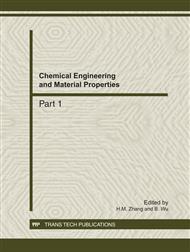p.1153
p.1159
p.1164
p.1168
p.1173
p.1179
p.1183
p.1189
p.1195
Removal of Strontium Ions from Aqueous Solution by Adsorption onto Sodium Trititanate Whisker
Abstract:
Utilization of solid-phase extraction (SPE) to remove aqueous strontium ions by adsorption onto activated sodium trititanate whisker (STW) was investigated in this work under the conditions of various pH value, STW amount, shaken time and contact time by flame atomic absorption spectrometry (FAAS). The optimum conditions obtained were: pH value = 5.0, STW amount = 0.2 g, shaken time = 5 min and contact time of 3 h on the remove of 2 mg·L-1 strontium(II). The adsorption of Sr(II) on activated STW follows pseudo-second order kinetics and the maximum adsorption capacity Q being 8.37 mg·g-1 at 25°C. Finally, the detection limit (3σ) of 0.030 μg·mL-1 with the relative standard deviation (RSD) for 1.0 μg·mL-1 Sr(II) of 0.93 % (n=10) were obtained. Results showed that activated STW was a solid-phase extraction sorbent of efficient, low-cost, convenient adsorption of Sr(II) from aqueous solution and could be reused for five times with about 8.0%-9.0% regeneration loss.
Info:
Periodical:
Pages:
1173-1178
Citation:
Online since:
December 2011
Authors:
Price:
Сopyright:
© 2012 Trans Tech Publications Ltd. All Rights Reserved
Share:
Citation:


